For all the critical scholarship that is written about the harnessing of volunteer labor in caring for urban trees (see, e.g., Perkins 2009), it never squared with my experience of engaging in stewardship. Following attendance at a human geography panel on ‘powerful objects’, I came to realize that my leisure practices were missing from my research accounts. I was writing myself out of the story, focusing only on the managerial logics of the state and civil society and the biophysical capacities and needs of the trees (Campbell 2014). The missing piece was the interactions of humans with trees, and what better way to explore those than through my own, first-hand accounts?
Inspired by Jones (2014) and Pearce et al. (2015) (see the reference below), I’ll share three stories of my engagements with street trees and reforestation sites to explore affective experiences between me and the trees. I believe that these vignettes offer windows into why and how we create and maintain relations of care with the urban forest.
Encounter 1: Street trees
Though I have worked for the US Forest Service in New York City since 2002, I had never taken part in street tree care. In the past, my colleagues and I used to joke that—despite working in the world of urban natural resource management—street trees made us sleepy. We felt they were too confined, like little toy soldiers, so neatly in their tree pits, standing in linear rows. We were interested in more open spaces—both physically and from a governance perspective—so we studied the conversion of lots to community gardens, the re-appropriation of public space for community memorials, and the restoration of contaminated urban waterways through civic action (Campbell 2006; Campbell and Wiesen 2009; Svendsen and Campbell 2010). But street trees remain the primary focus for many of our researcher and manager colleagues: they are the “stars” of the urban forestry show. These are the sites of quantification and valuation and of carefully constructed managerial practices. My only substantive prior involvement with them was in a research project on young street tree mortality (Lu et al. 2010), but I had never interacted with a street tree as a steward.
This changed in the spring of 2014, when a new tree appeared in the sidewalk outside the door to my apartment, courtesy of the NYC Parks Department and the MillionTreesNYC campaign. I did not request this tree via 311 (the New York City government’s service request number), nor did I know who did, but I suddenly felt excitement, ownership, and a sense of possibility. Here was my chance! To DO some of things I sat around yammering about in MillionTreesNYC Advisory Committee meetings or painstakingly studying for my dissertation. I didn’t have a yard, or a roof garden, and my prior community garden plot (in a privately owned, unlicensed site) had been overrun three times—first by mosquitoes, then by the cantankerous landowner, then by Hurricane Sandy. So I had no growing space. My partner, Ricardo, and I eagerly jumped at the chance to “adopt” this tree, writing out names on the tag attached to the trunk of this “wireless Zelkova”—so named because it was bred to perform well in the context of overhead utility wires, which few neighborhoods in New York City have, but which are prominent in my waterfront neighborhood of Red Hook, Brooklyn.
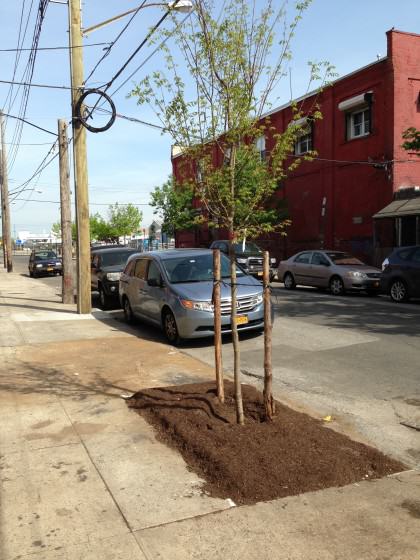
Red Hook street tree. Photo: Lindsay Campbell 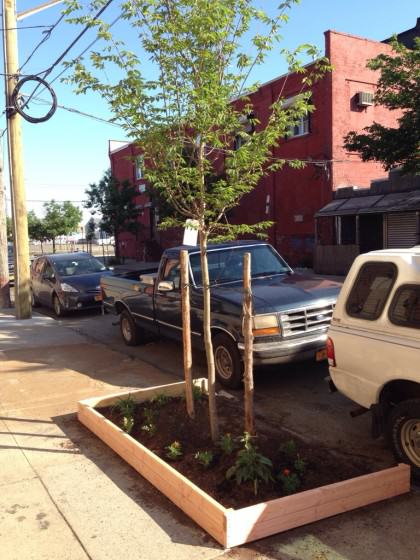
Tree with guard and plantings. Photo: Lindsay Campbell
Our first step was to build a tree “guard”—essentially a frame around the 9 x 5 foot tree pit—that would both protect the tree and aesthetically demarcate our garden bed. I queried my artist friends for ideas about how to build a funky guard out of found maritime objects, signaling the waterfront connection of my neighborhood and reusing waste. But I am neither an artist nor a very good scavenger, so ultimately this involved a dreaded trip to Lowes hardware store. About $100 later, we had our lumber (FSC certified and sustainable), stakes, fasteners, and a few plants. (Some perennials, a few annuals just to get us started. From where? Who knows?). It is not lost on me that if you add up the ‘board feet’ of lumber surrounding the tree in the guard and the supportive stakes helping the young tree to get started, our little street tree’s volume of wood is dwarfed by the wood we use to protect it.
When we were outside building the guard, our downstairs neighbor came upon us with a perplexed look. She wanted to know if we had gotten permission to care for the tree. I proudly proclaimed that the tree was in the public right of way (PROW) and that the city wants us to care for trees. Ricardo silently pointed to our names on the Adopt-a-Tree tag, noting the tacit legitimacy that it gave us. I suddenly personally understood the sense of the PROW as a ‘grey area’, particularly for renters in a multi-unit building (see Rae et al. 2010). To whom did the tree “belong”? What really gave us the right to claim it? Our labor? Our capital expense? Calling ‘dibs’ on a tree tag? Once we put our meager plants in, I was shocked at how much space remained in the bed. I would have happily joined with other neighbors in planting out the garden bed a little more fully, but the rectangle did feel like a single serving size garden. The neighbor never inquired again, and the tree seemed to be “ours”.
As our attachment deepened, we began to anthropomorphize tree a bit. We named it (uncreatively) “Tree” and talked about it like our adoptive child. As recently cohabiting, childless partners, we were joking—but only sort of. We don’t have pets. We try to keep the houseplants alive. Tree came next. Most of the work involved lugging 10 gallon buckets of water down three flights of stairs. I kept urging Ricardo to befriend our downstairs bodega guys, to ask if we could use their sink or hose hook up, but I was too nervous to ask myself. Even though I shopped there nearly daily and said my polite hellos, the whole street corner life/Jane Jacobs/social cohesion thing is a lot harder to enact in real life than it is to just read about and coo over—especially when it involves asking a favor of someone. So, instead, we lugged the buckets up and down the stairs, trying our best to meet the recommended 20 gallons of water per week in the summer, but usually not making it, and using the degree of desiccation of our marigolds as a marker for when we really needed to water.
Eventually we experienced setbacks. As someone exited their car and knocked their car door against the tree guard, they ripped out one whole side of our guard. We dutifully repaired it. This happened again a few weeks later and then Ricardo and I were really crestfallen. But when we returned from work, someone else had repaired the guard. While we are pretty sure it was our building super who was constructing a new trash shed, we preferred to think of it as some anonymous Good Samaritan. More generally, I was worried about the structural soundness of the guard overall. Looking at the completed work, it looked strikingly like a playground balance beam and was just crying out to be walked, stood, or balanced upon. Though I never witnessed it happening at our tree, I’d see this throughout the neighborhood on other tree guard sites. Also, we had a new hipster art space just two doors down, and all the parties and openings to go with it; this led to a rise in the foot traffic and cigarette butts we encountered on the street. Most mornings I would stoop to clean the accumulated garbage out of the pit. Further, my former roommate was dog-sitting and he informed me that “Ginger just loves the new bathroom outside!” Horrified, I explained that the dog urine was bad for the tree and our little plants, and he really should curb her. Yet, when I helped out by walking Ginger one day, I couldn’t bring myself to stop her from crouching on the bit of available dirt that she scurried to—it just felt like she had to scratch her feet in the dirt, and making her crouch on the concrete didn’t respect her dog-hood. But, I still didn’t let her use our tree. So we made a sign: “Please keep tree healthy—no butts or mutts.”
The big setback came on a fall morning in 2014 when I was awoken to the sound of jack hammers. As I left for work, I opened the door to see three of my building owner’s contractors operating a bobcat, tearing out the sidewalk. The tree guard was ripped out, Tree’s dirt was splayed about, and chunks of concrete mounded on the corner. Ricardo asked the workers to replace the guard when their work on the sidewalk was done, and they assured us they would.
A few days and one angry email to my landlord later, the guard was indeed restored. We breathed a sigh of relief: Tree was safe and protected—for now.
Encounter 2: Reforestation sites
Planting Trees
I headed out to Alley Pond Park in northeastern Queens, NY on a spring day in 2013 for my first urban afforestation planting experience. I knew Alley Pond from my work as being one of the sites that the NYC Parks Department natural resource folks were most proud of—closed canopy, tall trees, wide mulch and dirt paths—you really get the feeling of the forest in Alley Pond. But like so many of New York City’s ‘natural areas’, it is highly patchy and variable across space, criss-crossed and subdivided by a spaghetti of deep-Queens major roadways—the Cross Island Parkway, the Grand Central Parkway, and the Long Island Expressway.
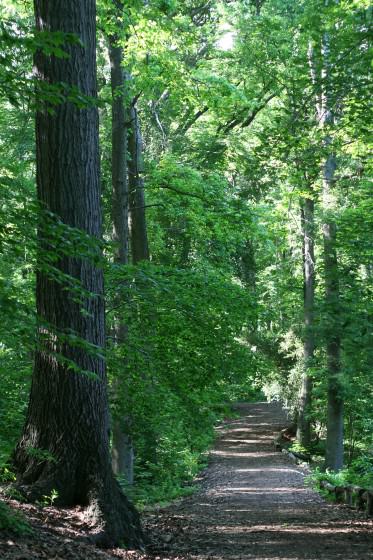
The corner of Alley Pond that we approached that day in which to ‘plant a forest’ was unfamiliar to me, and didn’t look much like the soaring, large canopy trees I’d seen in other sections. It was just a wide open, slightly sloping field, pockmarked with hundreds of holes and young trees at the ready. As I set to work, it felt so satisfying to fill the holes, nestling each tree comfortably in its spot, and moving on to the next, like crossing off an item in a to-do list, or fitting in a puzzle piece.
But what I noticed more than the site that day, or even interacting with the trees, were the social dynamics at work. The first thing I felt was the energy and enthusiasm of the staff. They knew how to treat us right—a quick entry sign-in, free breakfast, coffee, garden gloves, ample tools, quick demo, and off you go! Ricardo and I got into quite a rhythm. We didn’t really talk to others while we were working—there was work to do.
We hadn’t come with a big corporate group—we lacked the matching hats or tee shirts that immediately identified those folks. But as our backs tired and we slowed down, I lifted my head up from the dirt and saw friends, co-workers, and their children. It was a great equalizer between my colleague’s seven year old son, me, and the Deputy Commissioner of the Parks Department. The suits were off, it felt familial and easy. Eating my box lunch in the sun, sitting on the ground, talking to other tree planters was probably my favorite part of the day.
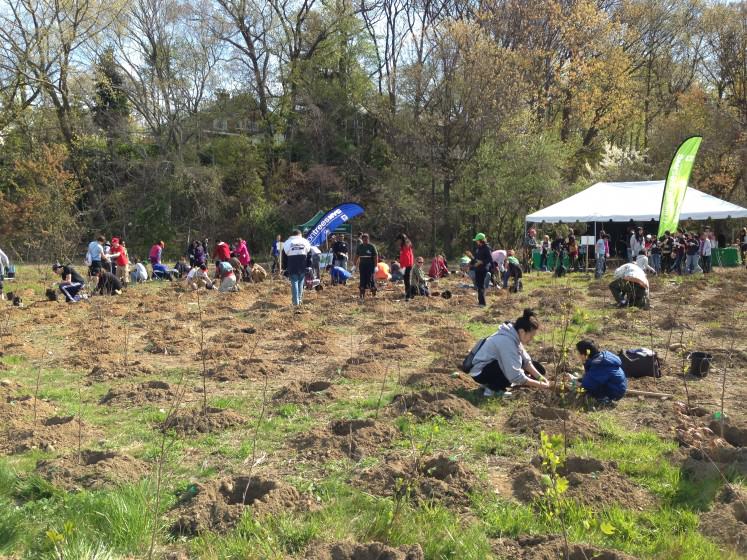
Stewarding Trees
As the MillionTreesNYC campaign began to wrap up in fall 2014, the Parks Department organized large-scale stewardship days along with planting days. So, I returned to (yet another section of) Alley Pond Park in Queens to see what it was like to steward a young forest. We were greeted with some granola bars, work gloves, and told to wait. A bit less scripted than the mass plantings, this was a smaller site with a few dozen people and one BIG pile of mulch. We were sent out in groups of around ten, and those of us stragglers that came without a team or group (like Ricardo and me) had to wait for a sufficient posse to be sent out. I have to say this made me feel a little orphaned. We watched patiently as four tiny girl scouts pushed a wheelbarrow that one of us could have handled. At points, there were not enough buckets for everyone to have one. Like so many volunteer experiences, the point here was not efficiency of labor; it was about inclusion, intention, fun, and engagement. Still, I wanted to feel useful.
When it was our turn to go, we got a pep talk about how “planting trees is just the beginning;” Parks workers demonstrated how to properly mulch a young tree by making a donut around it. The point of this mulch was less to enhance the soil and more to help keep out weeds and give the young native tree a fighting chance against the vines, Ailanthus, and other invasives surrounding it. They didn’t expressly instruct us to pull weeds, but pull we did. Even with the gloves, I gave myself callouses from pulling so many weeds. Ricardo wrenched his back doing battle against an Ailanthus root. While I could sit in a conference room and debate novel ecosystems and the language of native versus invasive, when I was here—in the field—I was pulling out those invasives, for sure. My colleague, who has much stronger ecology chops than I do, couldn’t help but comment on the possible futility of the effort—all while she, too, was pulling weeds. Those Ailanthus trees would return. Maybe it was futile, but it was fun. It felt like we were doing good. But looking around the site, she noted the proximity to a wetland, and wondered whether these young oaks even ‘belonged’ in this site. Perhaps other species of grasses and bushes would have been more appropriate?
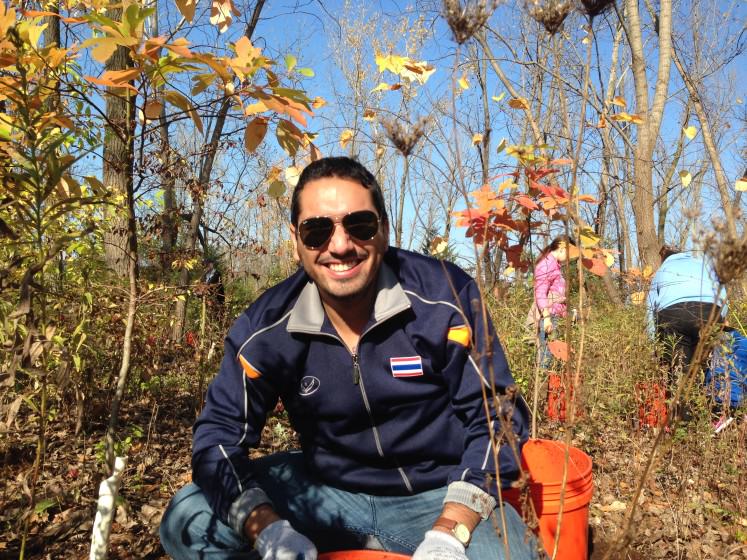
Ricardo stewarding trees. Photo: Lindsay Campbell 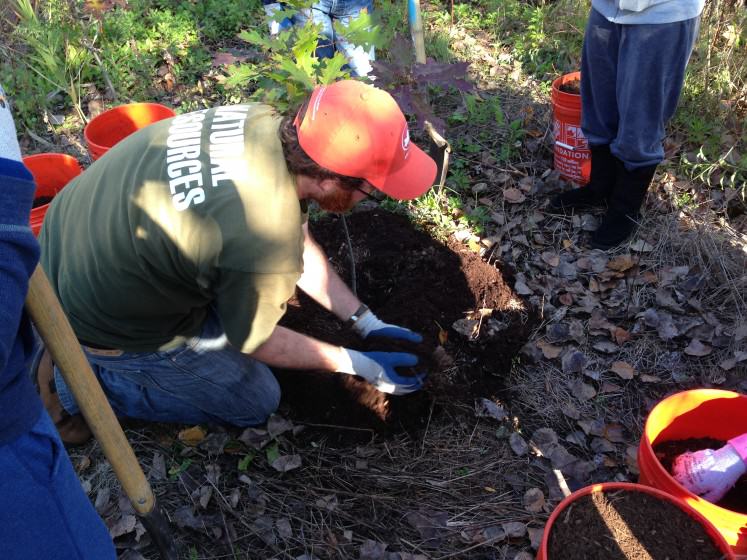
NYC Parks employee showing how to mulch a tree. Photo: Lindsay Campbell 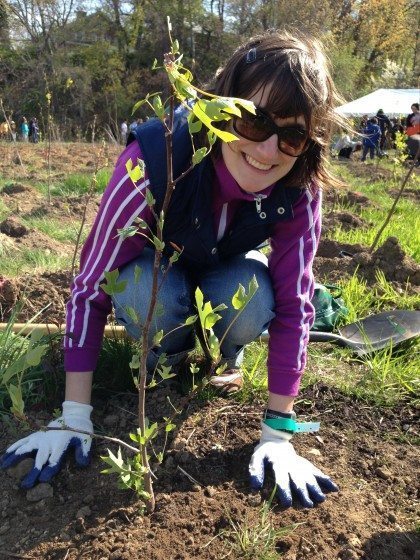
The author planting trees.
Once we cleaned out vines and weeds, we noted how far away the site was from the desired goal of ‘closing the canopy’. Talking with one of the Park workers, he mentioned that he thought it was one of the forest research sites, which meant that managers weren’t going in and planting additional trees, but were letting the forest competition play out—while still holding stewardship events like ours. I realized that—if he was right—I was the embodiment of a variable in the experimental forest plot treatments (mulch / no mulch) that some of my ecology colleagues were involved in running. We would have to wait decades for this experiment to unfold before we knew the outcomes of different treatments. Did it make sense to plant a forest in this site? Would it even work? The managers and stewards working on the site have to take these future outcomes as uncertain—as leaps of faith.
As before, the day concluded with box lunches, which we consumed while sitting on our overturned mulch buckets. Surrounded by a few dozen other New Yorkers, we chatted about the challenges of growing a forest in the city. And we went home that afternoon to plant fall bulbs around our own beloved Tree.
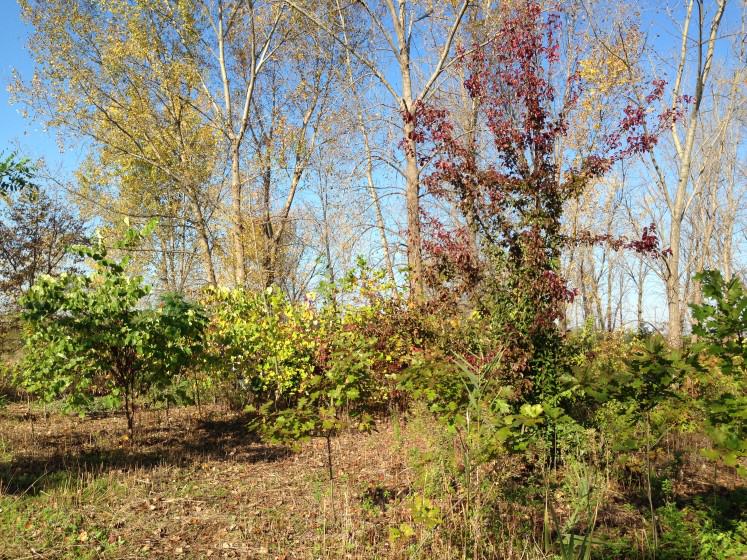
Concluding thoughts
By placing myself more centrally in these accounts, I present a ‘situated science’ approach to the subject of the urban forest (see Haraway 1991). Paying attention to social context, emotional ties, and affective registers tells a different tale than a remotely sensed, infrared image of urban tree canopy or the quantified accounting of ecosystem services provided by trees. These human-tree connections that we build require different methodological tools to uncover and certainly require a different understanding of what constitutes a research account. But I believe that sharing these stories helps move us towards a fuller understanding of why we create and maintain urban forests.
My relations with urban trees are complex. They are mediated by my needs, assumptions, and values. As these relations move beyond the conceptual and intellectual realms and into the physical and embodied, some of my assumptions have begun to shift:
Taking care of street trees isn’t as easy as I thought. Barriers like access to power tools and water sources are not trivial. Still, I’m willing to overcome these obstacles slowly, imperfectly, and over time. I don’t have a green thumb, I’ll learn through trial and error over the seasons as the tree and I grow together. Over the past year or so, the 45 square foot patch of land where my street tree is planted has come to occupy a much larger space in my mind and heart. I care for Tree, I fawn over Tree. I feel pride when I plant some new native grasses, I feel defensive when I swat off the squirrels. I feel angry when people litter or break the guard. I feel worried about whether Tree will make it through this brutal winter, as big drifts of snow mound up over the guard. I never could have predicted how much time and effort I would expend caring for Tree. But, I am also surprised by all that I have gotten in return from developing a real attachment to a piece of ground and caring for an organism situated within it.
On reforestation sites, I was surprised to learn that I like working hard, for free, on behalf of an effort greater than myself. I’ve come to understand why so many of the volunteer tree planters became repeat attendees, as my colleagues have shown in their work on the links between tree planting and civic engagement (Fisher et al. 2011, 2015). Even though the MillionTreesNYC campaign wasn’t originally conceived with a community forestry ethos, these volunteer events had evolved that way. The tree became the widget to bring people together. What mattered was what surrounded those trees: all of us.
The question remains, then, how can we build bridges between these emotional experiences and our management practices? How can we scale up from individual experiences that are deep but uneven across the population (dedicated street tree stewards) or far-reaching but isolated in time and space (one-time reforestation volunteer events)? How can we cultivate attachment and stewardship but also allow attachment to inform management, decision-making, and priority-setting? What would it look like to grow a forest that is rooted in these community relations all along the way? How can we truly honor relations of care between humans and trees and set ourselves up to create more of these experiences throughout the cycle of creating and maintaining an urban forest—from site selection, to material sourcing, to installation, to maintenance, to removal and reuse?
Lindsay K. Campbell
New York
Works Cited
Campbell, Lindsay K. 2014. “Constructing New York City’s urban forest: The politics and governance of the MillionTreesNYC campaign.” in Urban Forests, Trees, and Green Space: A Political Ecology. L. Anders Sandberg, Adrina Bardekjian, and Sadia Butt, Eds. Routledge Press, pp. 242-260.
—. 2006. Civil Society Strategies on Urban Waterways: Stewardship, Contention and Coalition Building. Master of City Planning Thesis. Department of Urban Studies and Planning, Massachusetts Institute of Technology. 169 p.
Campbell, Lindsay and Anne Wiesen, Eds. 2009. Restorative Commons: Creating Health and Well-being through Urban Landscapes. General Technical Report. Newtown Square, PA: U.S. Department of Agriculture, Forest Service, Northern Research Station.
Fisher, Dana L.; Connolly, James J.; Svendsen, Erika S.; and Lindsay K. Campbell. 2011. Digging Together: Why people volunteer to help plant one million trees in New York City. Environmental Stewardship Project at the Center for Society and Environment of the University of Maryland White Paper #2. 36 p. Available online here.
Haraway, D. 1991. “Situated Knowledges: The Science Question in Feminism and the Privilege of Partial Perspective.” in Simians, Cyborgs, and Women. New York: Routledge.
Jones, Owain. 2014. “(Urban) Places of Trees: Affective Embodiment, Politics, Identity, and Materiality” in Urban Forests, Trees, and Green Space: A Political Ecology. L. Anders Sandberg, Adrina Bardekjian, and Sadia Butt, Eds. Routledge Press, pp. 111-131.
Pearce, L. M., Davison, a., & Kirkpatrick, J. B. (2015). Personal encounters with trees: The lived significance of the private urban forest. Urban Forestry & Urban Greening, 14(1), 1–7.
Perkins, H. A. (2009). Out from the (Green) shadow? Neoliberal hegemony through the market logic of shared urban environmental governance. Political Geography, 28(7), 395–405.
Svendsen, Erika S. and Lindsay K. Campbell. 2010. “Living Memorials: Understanding the social meanings of community-based memorials to September 11, 2001.” Environment and Behavior, 42: 318-334.
